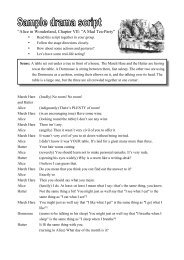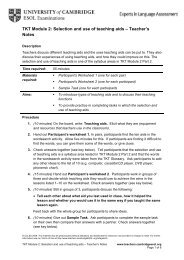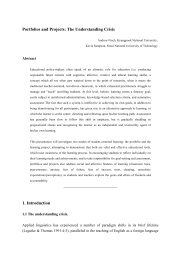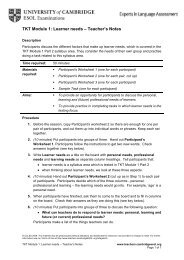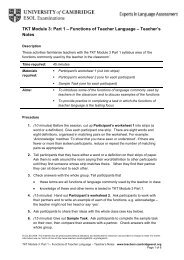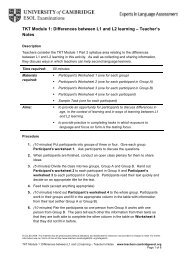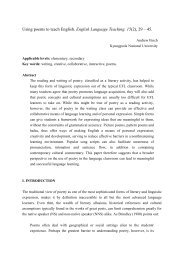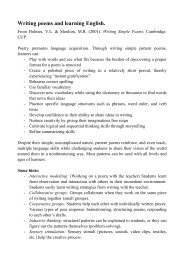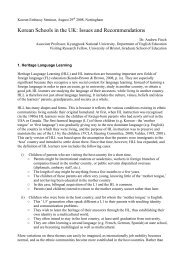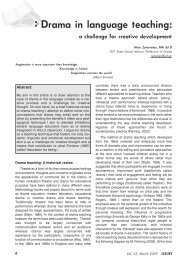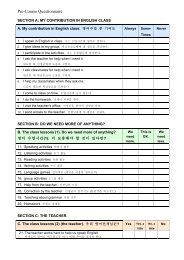Selection and use of coursebook materials - Finchpark
Selection and use of coursebook materials - Finchpark
Selection and use of coursebook materials - Finchpark
Create successful ePaper yourself
Turn your PDF publications into a flip-book with our unique Google optimized e-Paper software.
TKT Module 2: <strong>Selection</strong> <strong>and</strong> <strong>use</strong> <strong>of</strong> <strong>coursebook</strong> <strong>materials</strong> –<br />
Teacher’s Notes<br />
Description<br />
This activity foc<strong>use</strong>s on the selection <strong>and</strong> <strong>use</strong> <strong>of</strong> <strong>coursebook</strong> <strong>materials</strong>, which is tested in<br />
TKT Module 2 Part 2. Participants consider various criteria for choosing <strong>coursebook</strong>s, then<br />
consider problems teachers may have with their <strong>coursebook</strong> <strong>and</strong> ways <strong>of</strong> solving these<br />
problems.<br />
Time required:<br />
Materials<br />
required:<br />
50 minutes<br />
• Blank pieces <strong>of</strong> paper (one for each participant)<br />
• Participant’s Worksheet 1 (cut into strips, one set for each pair)<br />
• Participant’s Worksheet 2 (one for each participant)<br />
• Participant’s Worksheet 3 (cut or folded in half, one for each<br />
participant)<br />
• Sample Task (one for each participant)<br />
Aims: • To provide an opportunity for participants to consider criteria for<br />
selecting <strong>coursebook</strong>s.<br />
Procedure<br />
• To provide an opportunity for participants to discuss ways <strong>of</strong><br />
adapting <strong>coursebook</strong> <strong>materials</strong>.<br />
• To provide practice in completing tasks in which the selection <strong>and</strong><br />
<strong>use</strong> <strong>of</strong> <strong>coursebook</strong> <strong>materials</strong> is the testing focus.<br />
1. (10 minutes) Give each participant a blank piece <strong>of</strong> paper. Participants write one<br />
thing they like about <strong>coursebook</strong>s <strong>and</strong> one thing they don’t like about <strong>coursebook</strong>s on<br />
their paper. They then exchange papers with a partner <strong>and</strong> read <strong>and</strong> discuss each<br />
others’ comments about <strong>coursebook</strong>s.<br />
2. Feed back with the whole group so that participants can share their opinions.<br />
Explain that the selection <strong>and</strong> <strong>use</strong> <strong>of</strong> <strong>coursebook</strong> <strong>materials</strong> is a syllabus area tested<br />
in TKT Module 2 Part 2.<br />
3. (10 minutes) Put participants into pairs. Give each pair Participant’s Worksheet 1<br />
cut into strips. Explain that the strips <strong>of</strong> paper give criteria for selecting <strong>coursebook</strong>s<br />
(teachers’ reasons for choosing a particular <strong>coursebook</strong>). Participants discuss which<br />
<strong>of</strong> the criteria they think are more important <strong>and</strong> which are less important. They<br />
should rank the criteria in order <strong>of</strong> importance, with the most important at the top.<br />
4. Feed back with the whole group so that participants can share their opinions (there is<br />
no set answer to this exercise. Teachers will have different views on what is<br />
important).<br />
© UCLES 2009. This material may be photocopied (without alteration) <strong>and</strong> distributed for classroom <strong>use</strong> provided no charge is made. For further<br />
information see our Terms <strong>of</strong> Use at http://www.teachers.cambridgeESOL.org/ts/legalinfo<br />
TKT Module 2: <strong>Selection</strong> <strong>and</strong> <strong>use</strong> <strong>of</strong> <strong>coursebook</strong> <strong>materials</strong> – Teacher’s Noteswww.teachers.cambridgeesol.org<br />
Page 1 <strong>of</strong> 7
5. (10 minutes) Participants work in groups <strong>of</strong> three. Give out Participant’s worksheet<br />
2. Participants discuss in their groups what they would suggest the teachers do<br />
about the problems listed on the worksheet.<br />
6. Give out Participant’s Worksheet 3 Exercise 1 (cut or fold this before the session).<br />
Participants match the suggested solutions with the problems on Participant’s<br />
worksheet 2. Check answers together (see key below).<br />
7. (10 minutes) Still in groups <strong>of</strong> three, participants discuss specific strategies to<br />
achieve the solutions suggested in Step 6. Elicit an example, e.g.:<br />
1. The reading <strong>and</strong> listening material in the <strong>coursebook</strong> is too difficult.<br />
Use supplementary <strong>materials</strong> instead./ Re-write the tasks to make them easier./<br />
Ask more general questions./ Only work with a part <strong>of</strong> the text.<br />
8. Give out/Refer participants to Participant’s Worksheet 3 Exercise 2. In their<br />
groups, participants match the strategies with the problems <strong>and</strong> solutions on<br />
Participant’s Worksheet 2. Check answers together (see key below).<br />
9. (10 minutes) Give out Sample Task. Participants complete the sample task on their<br />
own then compare their answers with a partner. Check answers together (see key<br />
below).<br />
10. (5 minutes) Round up to summarise points covered. Ask participants:<br />
• What is the TKT Module 2 syllabus area for this lesson (the selection <strong>and</strong><br />
<strong>use</strong> <strong>of</strong> <strong>coursebook</strong> <strong>materials</strong>)<br />
• What is the testing focus on this syllabus area (criteria for selecting<br />
<strong>coursebook</strong> <strong>materials</strong> <strong>and</strong> ways <strong>of</strong> adapting <strong>coursebook</strong> <strong>materials</strong>)<br />
• When looking at <strong>coursebook</strong> activities, what things do teachers needs to<br />
consider (suitability <strong>of</strong> tasks <strong>and</strong> topics in the <strong>coursebook</strong> for their learners,<br />
types <strong>of</strong> activities, <strong>and</strong> aims <strong>of</strong> activities <strong>and</strong> tasks)<br />
© UCLES 2009. This material may be photocopied (without alteration) <strong>and</strong> distributed for classroom <strong>use</strong> provided no charge is made. For further<br />
information see our Terms <strong>of</strong> Use at http://www.teachers.cambridgeESOL.org/ts/legalinfo<br />
TKT Module 2: <strong>Selection</strong> <strong>and</strong> <strong>use</strong> <strong>of</strong> <strong>coursebook</strong> <strong>materials</strong> – Teacher’s Noteswww.teachers.cambridgeesol.org<br />
Page 2 <strong>of</strong> 7
TKT Module 2: <strong>Selection</strong> <strong>and</strong> <strong>use</strong> <strong>of</strong> <strong>coursebook</strong> <strong>materials</strong> – Answer<br />
Keys<br />
Key to Participant’s Worksheet 3 Exercise 1<br />
1 B 2 E 3 C 4 A 5 F 6 D 7 B 8 A<br />
Key to Participant’s Worksheet 3 Exercise 2<br />
1 D <strong>and</strong> F 2 H <strong>and</strong> J 3 A 4 B <strong>and</strong> G<br />
5 J 6 C <strong>and</strong> F 7 I 8 E<br />
Key to Sample Task<br />
1. E 2. G 3. F 4. C 5. B 6 A<br />
© UCLES 2009. This material may be photocopied (without alteration) <strong>and</strong> distributed for classroom <strong>use</strong> provided no charge is made. For further<br />
information see our Terms <strong>of</strong> Use at http://www.teachers.cambridgeESOL.org/ts/legalinfo<br />
TKT Module 2: <strong>Selection</strong> <strong>and</strong> <strong>use</strong> <strong>of</strong> <strong>coursebook</strong> <strong>materials</strong> – Answer Keys<br />
www.teachers.cambridgeesol.org<br />
Page 3 <strong>of</strong> 7
TKT Module 2: <strong>Selection</strong> <strong>and</strong> <strong>use</strong> <strong>of</strong> <strong>coursebook</strong> <strong>materials</strong> –<br />
Participant’s Worksheet 1<br />
1. The material in the <strong>coursebook</strong> is visually attractive. The <strong>coursebook</strong> has<br />
different colours, fonts <strong>and</strong> headings.<br />
2. There are a variety <strong>of</strong> different practice activities which allow students to <strong>use</strong><br />
the language taught.<br />
3. The topics <strong>and</strong> contexts in the <strong>coursebook</strong> are familiar to the students <strong>and</strong> are<br />
motivating to suit the age, needs, experience <strong>and</strong> interests <strong>of</strong> the students in<br />
the class.<br />
4. The <strong>coursebook</strong> has a good balance between grammar <strong>and</strong> skills<br />
development.<br />
5. The <strong>coursebook</strong> has the same number <strong>of</strong> units as the number <strong>of</strong> weeks <strong>of</strong> the<br />
course, i.e. the course runs for twelve weeks <strong>and</strong> there are twelve units.<br />
6. The <strong>coursebook</strong> is the right level for the learners in the class.<br />
7. There is material covering all four skills in the <strong>coursebook</strong> – reading, writing,<br />
listening <strong>and</strong> speaking.<br />
8. The material in the <strong>coursebook</strong> is well-organised <strong>and</strong> it is easy for teachers <strong>and</strong><br />
students to follow what they have to do.<br />
9. There is variety in the way new language is presented in the <strong>coursebook</strong>.<br />
10. The reading <strong>and</strong> listening <strong>materials</strong> have an authentic feel <strong>and</strong> look. The texts<br />
look like they are real articles <strong>and</strong> the recordings sound like real conversations.<br />
© UCLES 2009. This material may be photocopied (without alteration) <strong>and</strong> distributed for classroom <strong>use</strong> provided no charge is made. For further<br />
information see our Terms <strong>of</strong> Use at http://www.teachers.cambridgeESOL.org/ts/legalinfo<br />
TKT Module 2: <strong>Selection</strong> <strong>and</strong> <strong>use</strong> <strong>of</strong> <strong>coursebook</strong> <strong>materials</strong> – Participant’s Worksheet 1<br />
www.teachers.cambridgeesol.org<br />
Page 4 <strong>of</strong> 7
TKT Module 2: <strong>Selection</strong> <strong>and</strong> <strong>use</strong> <strong>of</strong> <strong>coursebook</strong> <strong>materials</strong> –<br />
Participant’s Worksheet 1<br />
Exercise 2<br />
Look at the teachers’ problems with <strong>coursebook</strong>s <strong>and</strong> discuss what solutions you<br />
would suggest. There is one example.<br />
Teachers’ problems with<br />
the <strong>coursebook</strong> material<br />
1. The reading <strong>and</strong> listening<br />
material in the <strong>coursebook</strong> is<br />
too difficult.<br />
Solutions (What could you<br />
do)<br />
Change the level <strong>of</strong> the<br />
material.<br />
Strategies (How would<br />
you do it)<br />
2. The <strong>coursebook</strong> has the<br />
students doing the same<br />
things in each unit.<br />
3. The texts <strong>and</strong> tasks in the<br />
<strong>coursebook</strong> are too short.<br />
4. There is very little authentic<br />
material for listening <strong>and</strong><br />
reading.<br />
5. The tasks in the<br />
<strong>coursebook</strong> are in the same<br />
order in every unit.<br />
6. The texts <strong>and</strong> tasks in the<br />
<strong>coursebook</strong> are too long.<br />
7. The reading <strong>and</strong> listening<br />
material in the <strong>coursebook</strong> is<br />
too easy.<br />
8. There is little free speaking<br />
<strong>and</strong> no writing practice in the<br />
<strong>coursebook</strong>.<br />
© UCLES 2009. This material may be photocopied (without alteration) <strong>and</strong> distributed for classroom <strong>use</strong> provided no charge is made. For further<br />
information see our Terms <strong>of</strong> Use at http://www.teachers.cambridgeESOL.org/ts/legalinfo<br />
TKT Module 2: <strong>Selection</strong> <strong>and</strong> <strong>use</strong> <strong>of</strong> <strong>coursebook</strong> <strong>materials</strong> – Participant’s Worksheet 1<br />
www.teachers.cambridgeesol.org<br />
Page 5 <strong>of</strong> 7
TKT Module 2: <strong>Selection</strong> <strong>and</strong> <strong>use</strong> <strong>of</strong> <strong>coursebook</strong> <strong>materials</strong> –<br />
Participant’s Worksheet 1<br />
Exercise 1<br />
Here are some suggestions <strong>of</strong> possible solutions for teachers’ problems with<br />
<strong>coursebook</strong>s. Match them with the problems on Participant’s worksheet 2. Use some<br />
<strong>of</strong> the letters more than once.<br />
A. Find different material to <strong>use</strong> with the <strong>coursebook</strong> – supplementary material.<br />
B. Change the level <strong>of</strong> the material.<br />
C. Extend the task.<br />
D. Shorten the task.<br />
E. Change the way the task works.<br />
F. Use the material in a different order.<br />
_____________________________________________________________________<br />
Exercise 2<br />
Match these strategies for implementing the solutions to teachers’ problems with<br />
<strong>coursebook</strong>s with the problems on Participant’s worksheet 2.<br />
A. Write extra questions or add a paragraph <strong>of</strong> your own to a text.<br />
B. What about using songs as listening material<br />
C. Cut up texts/provide multiple recordings <strong>and</strong> do jigsaw reading/listening tasks, so that<br />
students have less to read or listen to.<br />
D. Re-write the tasks to make them easier. Ask more general questions.<br />
E. Use productive skills <strong>materials</strong> from other <strong>coursebook</strong>s or from the internet to provide<br />
fluency practice.<br />
F. Reduce texts by removing a difficult paragraph or break recorded material into<br />
‘chunks’ or sections.<br />
G. Use the internet to find interesting articles for students to read.<br />
H. Use different interaction patterns. Cut up tasks to make them matching tasks or<br />
ordering tasks.<br />
I. Re-write the tasks to make them more challenging. Learners need to read for more<br />
detailed information or need to predict answers before they read or listen.<br />
J. Do the activities in a different order. Students can cover sections <strong>of</strong> the book that<br />
you don’t want them to look at.<br />
© UCLES 2009. This material may be photocopied (without alteration) <strong>and</strong> distributed for classroom <strong>use</strong> provided no charge is made. For further<br />
information see our Terms <strong>of</strong> Use at http://www.teachers.cambridgeESOL.org/ts/legalinfo<br />
TKT Module 2: <strong>Selection</strong> <strong>and</strong> <strong>use</strong> <strong>of</strong> <strong>coursebook</strong> <strong>materials</strong> – Participant’s Worksheet 1<br />
www.teachers.cambridgeesol.org<br />
Page 6 <strong>of</strong> 7
TKT Module 2: <strong>Selection</strong> <strong>and</strong> <strong>use</strong> <strong>of</strong> <strong>coursebook</strong> <strong>materials</strong> – Sample<br />
Task<br />
For questions 1–6, match the ways a teacher can adapt a written text with the teaching<br />
purposes listed A–G.<br />
Mark the correct letter (A–G) on your answer sheet.<br />
There is one extra option which you do not need to <strong>use</strong>.<br />
Teaching purposes<br />
A<br />
B<br />
C<br />
D<br />
E<br />
F<br />
G<br />
to focus on linking words <strong>and</strong> phrases<br />
to raise learners’ awareness <strong>of</strong> register<br />
to make the text more accessible to weaker learners<br />
to generate interest in the topic<br />
to highlight particular grammatical patterns<br />
to develop learners’ pro<strong>of</strong>reading skills<br />
to work out meaning from surrounding context<br />
Ways a teacher can adapt a written text<br />
1 removing from the text all the verbs which follow prepositions<br />
2<br />
replacing nouns with nonsense words <strong>and</strong> asking learners to provide the original<br />
words<br />
3 putting some spelling mistakes into the text<br />
4 shortening the text <strong>and</strong> paraphrasing parts <strong>of</strong> it<br />
5 re-writing the text in an informal style <strong>and</strong> learners compare it with the original<br />
6 jumbling the paragraphs <strong>and</strong> asking learners to re-order them correctly<br />
© UCLES 2009. This material may be photocopied (without alteration) <strong>and</strong> distributed for classroom <strong>use</strong> provided no charge is made. For further<br />
information see our Terms <strong>of</strong> Use at http://www.teachers.cambridgeESOL.org/ts/legalinfo<br />
TKT Module 2: <strong>Selection</strong> <strong>and</strong> <strong>use</strong> <strong>of</strong> <strong>coursebook</strong> <strong>materials</strong> – Sample Task<br />
www.teachers.cambridgeesol.org<br />
Page 7 <strong>of</strong> 7



